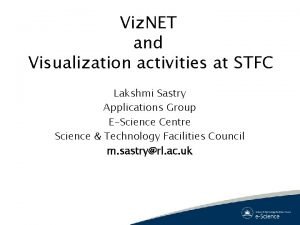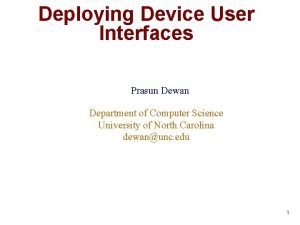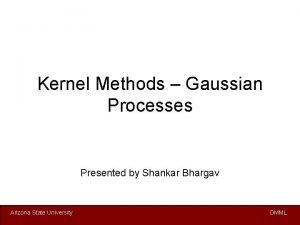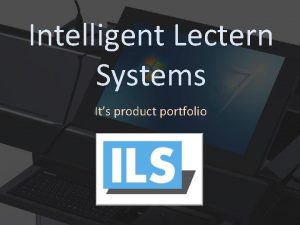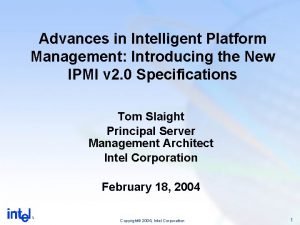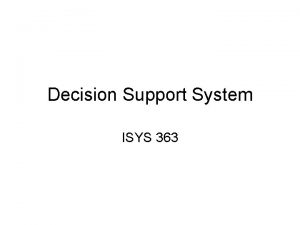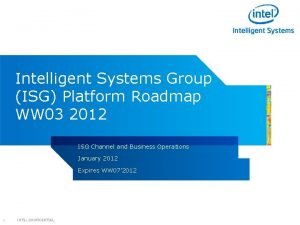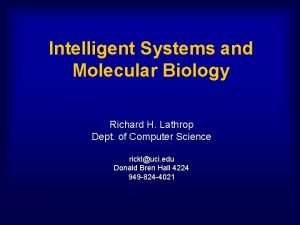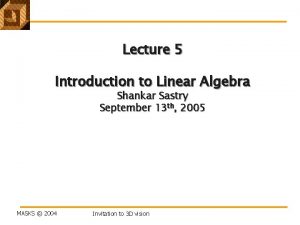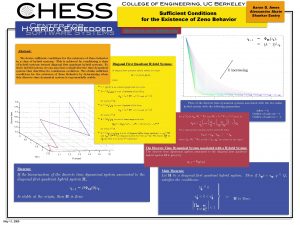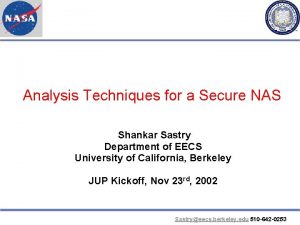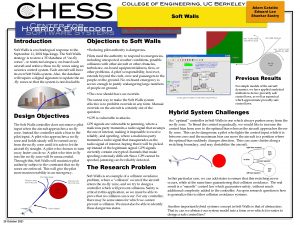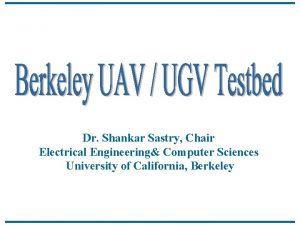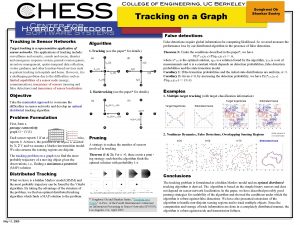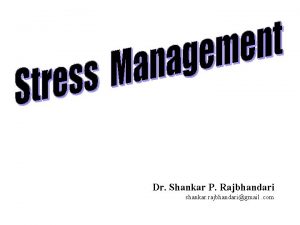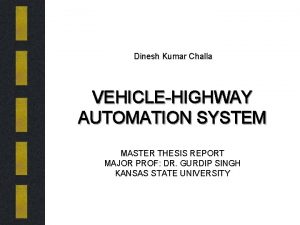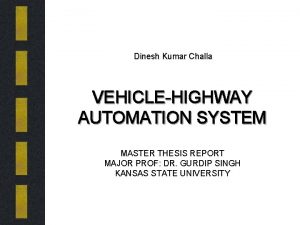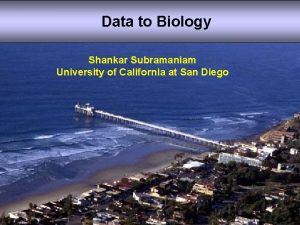Intelligent VehicleHighway Systems Shankar Sastry California PATH University















- Slides: 15

Intelligent Vehicle-Highway Systems Shankar Sastry California PATH University of California, Berkeley (Joint work with Datta Godbole, John Lygeros, Raja Sengupta & Shankar Sastry)

Intelligent Vehicle-Highway Systems (IVHS) · Partially or fully automate driving on the highways – can increase driving comfort and reduce stress – potential for increased safety • 90% of all accidents are attributed to human error • Although many more hazards are successfully handled by humans. – Automation can induce structured environment and tight control resulting in high capacity, less pollution & guaranteed travel times · Types of Automation – Driver Warning & Assistance (e. g. , Blind Spot Warning) – Emergency Control (ABS, Daimler Chrysler schemes) – Control of Repetitive Tasks (Adaptive Cruise Control) – Complete Control (Automated Highway Systems) Systems

Control Problems in IVHS · Objectives – Increase safety & efficiency of the existing highway infrastructure • objectives of the individual users and the system may not match · Characteristics – Control Design: Multiple Agents Compete for Scarce Resources • Centralized control can yield optimal solutions but may be too complex and unreliable (danger of single point failure) • Decentralized control increases reliability but may result in non-optimal or even unsafe solutions. – Performance Evaluation • Performance metrics specified in terms of overall system whereas controllers designed for individual vehicles • Evaluation in the uncertain environment of partial automation

Automated Highway System · Fully Automated Vehicles Operating on Dedicated Lanes – Involves control of individual vehicles as well as their collective behavior · Conflicting Objectives – Safety & Capacity – Travel Time & Throughput (Individual vs System Optimal) · Definition of Safety – Ideally no collisions – Allowing low relative velocity collisions results in two acceptable longitudinal vehicle following configurations • Following very close (platoon follower) • Following at sufficiently large distance (platoon leader)

Automated Platoons on I-15 University of California, Berkeley

Control of Automated Highway Systems · Design of vehicle controllers & performance estimation · Two concepts – platooning & individual vehicles Network • Flow optimization Entry Join Link Coordination Regulation • Dynamic routing • Maneuver selection • inter-vehicle comm Lane Change Speed, vehicle following • Lane keeping • Vehicle following University of California, Berkeley Platoon Following Split Exit

Vehicle Following & Lane Changing i i-1 i-2 j · Control actions: (vehicle i) -- braking, lane change · Disturbances: (generated by neighboring vehicles) -- deceleration of the preceding vehicle -- preceding vehicle colliding with the vehicle ahead of it -- lane change resulting in a different preceding vehicles -- appearance of an obstacle in front · Operational conditions: – state of vehicle i with respect to traffic

Game Theoretic Formulation · Requirements – Safety (no collision) – Passenger Comfort – Efficiency • trajectory tracking (depends on the maneuver) · Safe controller (J 1): Solve a two-person zero-sum game – saddle solution (u 1*, d 1*) given by • Both vehicles i and i-1 applying maximum braking • Both collisions occur at T=0 and with maximum impact University of California, Berkeley

Safe Vehicle Following Controller · Partition the state space into safe & unsafe sets Design comfortable and efficient controllers in the interior • IEEE TVT 11/94 Safe set characterization also provides sufficient conditions for lane change • CDC 97, CDC 98 University of California, Berkeley

Automated Highway System Safety · Theorem 1: (Individual vehicle based AHS) – An individual vehicle based AHS can be designed to produce no inter-vehicle collisions, – moreover disturbances attenuate along the vehicle string. · Theorem 2: (Platoon based AHS) – Assuming that platoon follower operation does not result in any collisions even with a possible inter-platoon collision during join/split, a platoon based AHS can be safe under low relative velocity collision criterion. · References – Lygeros, Godbole, Sastry, IEEE TAC, April 1998 – Godbole, Lygeros, IEEE TVT, Nov. 1994 University of California, Berkeley

AHS Performance Evaluation · Estimate maximum per lane capacity as a function of – vehicle braking rates, delays, types of coordination · Individual vehicles can increase highway capacity by a factor of two: – on-line estimation of braking capability · Platooning provides similar capacity with the possibility of low impact velocity collisions – Consider: emergency deceleration for obstacle avoidance • differences in delays & braking rates give rise to multiple and severe intraplatoon collisions requiring larger separation between two platoons · References – Carbaugh, Godbole, Sengupta, Transportation Research-C, 98 – Godbole, Lygeros, Transportation Research-C, 99 University of California, Berkeley

Highway Capacity Estimate (Single-Lane) N=Platoon size Queuing Analysis • Up to 20% capacity loss due to entry and exit • Up to 15% loss due to lane changes • Platoon Join/Split ? ? References • Transportation Research part-C: 1998, 1999 University of California, Berkeley

Fault Management · Faults induce switching of control strategies at multiple levels of hierarchy to maintain safety and minimize performance degradation · Design of fault management system – fault identification (distributed observation) – fault classification – fault handling • minimal set of new maneuvers • fault localization • verified logical correctness of communication protocols · Need for probabilistic verification – worst-case design can not produce a safe system with faults – given component reliability & Pd-fa characteristic of fault identification algorithms, compute probability of collisions.

AHS Control Architecture Fault Mode i Network • Flow optimization Fault Mode j Link Network • Flow optimization • Dynamic routing Network • Flow optimization Link& efficient • Dynamic routing • Safe Coordination Control Switching Link • Dynamic routing • Inter-vehicle comm • Safe & efficient Coordination Control Switching • Multi-Objective Regulation • Inter-vehicle comm • Safe & efficient Control Design Coordination Control Switching • Multi-Objective • Inter-vehicle comm Regulation Control Design • Multi-Objective Regulation Control Design Analysis Methods and Tools System Performance Operating Scenario University of California, Berkeley

Deployment of AHS · Partial Automation yields progressive deployment path – Lack of structured environment – Lack of the knowledge of other driver’s intentions – Greedy driving policies – Human factors issues are highly pronounced • false alarms, nuisance alarms, driver attentiveness, risk compensation, role confusion (Godbole et. al. TRB 98; James Kuchar at MIT) · Designing concepts for partial automation – ACC only roadway with infrastructure assisted entry • (Godbole et. al. TRB 99) · Benefit Evaluation of partial automation systems – Hierarchical benefit evaluation methodology that integrates analysis, simulation and experimentation results • adopted by NHTSA for crash avoidance systems analysis at VOLPE labs
 Loughborough university vpn
Loughborough university vpn Lakshmi sastry md
Lakshmi sastry md Lakshmi sastry
Lakshmi sastry Decision support systems and intelligent systems
Decision support systems and intelligent systems Shankar gupta
Shankar gupta Shankar ponnekanti
Shankar ponnekanti Humpty dumpty shankar nagar raipur
Humpty dumpty shankar nagar raipur Sujay shankar
Sujay shankar Peter shankar
Peter shankar Intelligent lectern systems
Intelligent lectern systems Intelligent systems corporation
Intelligent systems corporation Isys intelligent systems
Isys intelligent systems Core intelligent systems platform
Core intelligent systems platform Intelligent systems for molecular biology
Intelligent systems for molecular biology Unity iot
Unity iot California state university long beach nursing
California state university long beach nursing
